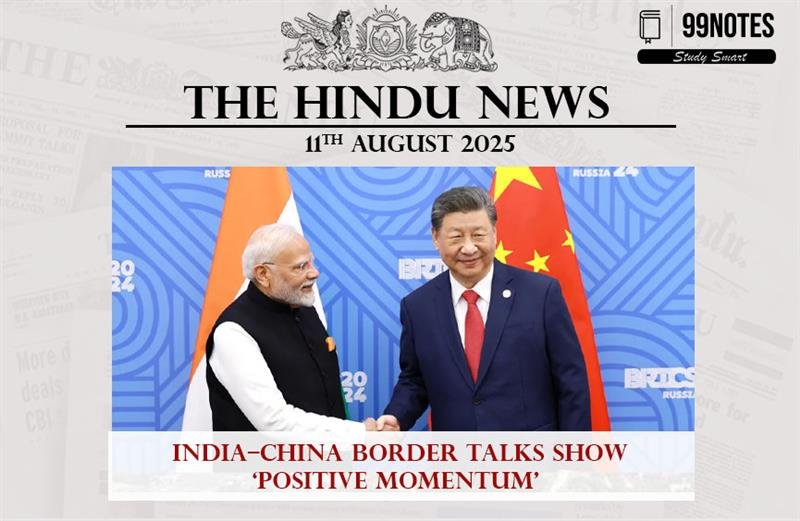11 August 2025: The Hindu Editorial
1. India–China Border Talks Show ‘Positive Momentum’
Source -Page 1, The Hindu
| Topic: GS2 – International Relations, Border Disputes, Security |
| Context |
|
Content:
Background to the Dispute
-
The India–China boundary dispute spans over 3,488 km across three sectors: Western (Ladakh), Middle (Himachal Pradesh and Uttarakhand), and Eastern (Sikkim and Arunachal Pradesh).
-
The Eastern Ladakh standoff began in May 2020 when Chinese forces crossed the LAC at multiple points — including Pangong Tso, Galwan Valley, Gogra–Hot Springs, and Depsang Plains.
-
The Galwan Valley clash in June 2020 resulted in the death of 20 Indian soldiers and an undisclosed number of Chinese casualties — the first such fatalities in 45 years.
Significance of the Current Talks
-
This was the 21st Corps Commander-level meeting, held at Chushul-Moldo border meeting point.
-
The talks focused on:
-
Disengagement at remaining friction points like Depsang and Demchok.
-
Restoring patrolling rights disrupted since 2020.
-
Maintaining confidence-building measures (CBMs) to prevent accidental escalation.
-
-
Both sides agreed to continue dialogue at both diplomatic and military levels.
Strategic Importance of Eastern Ladakh
-
Geopolitical Relevance:
-
Eastern Ladakh is critical for India’s access to the Karakoram Pass and Siachen Glacier.
-
It borders China’s Xinjiang and Tibet Autonomous Region.
-
-
Infrastructure Competition:
-
China has constructed all-weather roads, bridges, and forward posts near the LAC, including the G219 highway linking Xinjiang to Tibet.
-
India has accelerated projects like the Darbuk–Shyok–Daulat Beg Oldie (DSDBO) Road and the Siachen Airstrip upgrades.
-
Outstanding Issues
-
Depsang Plains: India claims Chinese troops are blocking access to Patrolling Points (PP) 10–13.
-
Demchok: Chinese presence in areas traditionally patrolled by Indian forces.
-
Troop Build-up: Despite partial disengagement, tens of thousands of troops remain deployed on both sides.
-
Trust Deficit: Repeated violations of past agreements (1993, 1996, 2005 protocols) have eroded confidence.
Implications for India’s Foreign Policy
-
China Factor in Multilateral Forums: Ongoing tensions influence cooperation in BRICS, SCO, and RIC groupings.
-
India–US and QUAD Relations: Disputes with China have accelerated India’s strategic convergence with the US, Japan, and Australia.
-
Trade Paradox: Despite tensions, bilateral trade crossed $100 billion in 2023, showing deep economic interdependence.
Concerns Going Forward
-
Winter Deployment: Harsh conditions increase logistical challenges and costs for both armies.
-
Possibility of Escalation: Even small-scale incidents can trigger larger confrontations.
-
China’s Two-Front Advantage: China’s partnership with Pakistan could complicate India’s western border security.
Way Forward
-
Military-to-Military Engagement: Regular hotlines and flag meetings to prevent misunderstandings.
-
Clear Roadmap: Time-bound disengagement with verification mechanisms.
-
Political-Level Intervention: Leader-to-leader talks to supplement the military process.
-
CBMs Renewal: Updating and enforcing the 1993 and 1996 agreements with stricter monitoring.
|
Practice Question: “Discuss the strategic, economic, and security dimensions of the India–China border dispute. What steps should be taken to ensure sustainable peace along the Line of Actual Control?” |
Read more about -8August 2025: The Hindu Editorial Analysis


